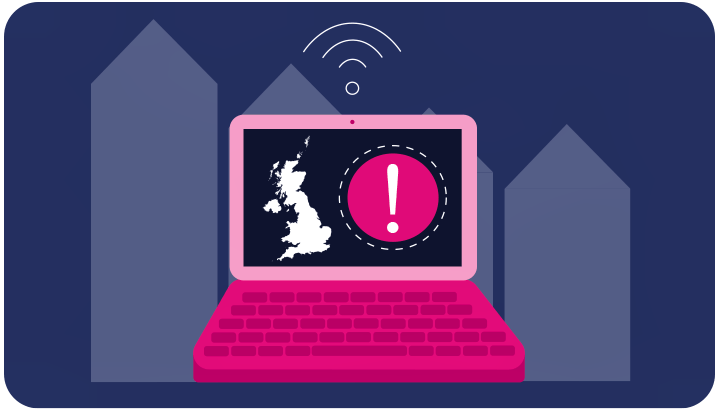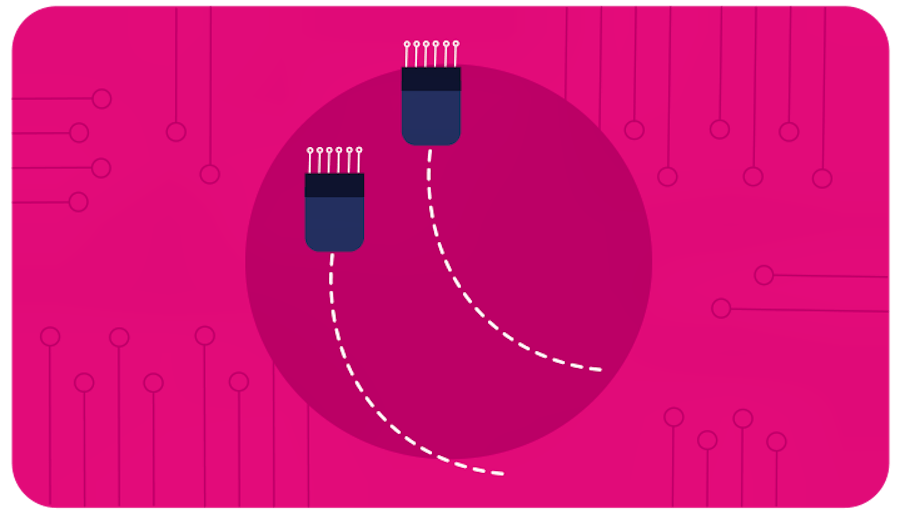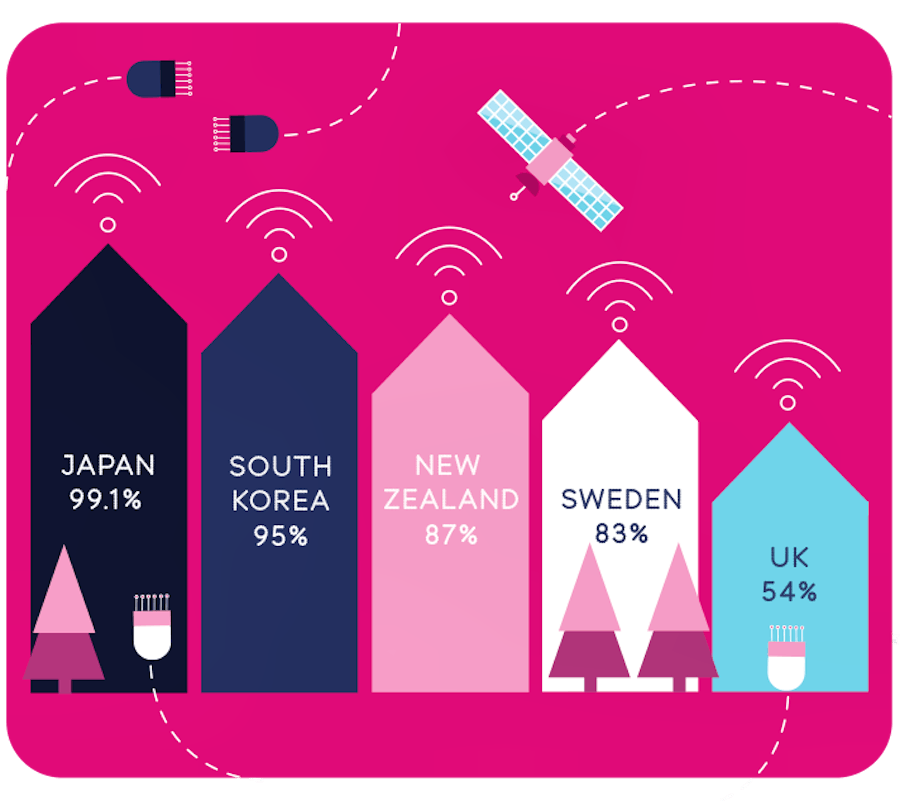Future Fibre: Where is broadband in the UK headed?
Is the UK keeping up with the latest broadband trends?

In today's digital age, access to high-speed internet is no longer a luxury but a necessity. Broadband has revolutionized the way we live, work, and communicate.
As we move forward, the future of broadband in the UK is poised for even greater transformation, driven by technological innovation and increasing demand for connectivity. But are we keeping up with the current demand?
Find out here as we delve into broadband in the UK, looking at its current state in the nation and where it is headed.
Broadband in the UK: Rise of ultrafast broadband
As the need for better broadband across the nation grows, the technology available improves to be able to handle it all.
That is where ultrafast broadband comes in, providing incredible speeds that even 15 years ago sounded like an alien concept.
Ultrafast is the second category of broadband speed if you will. Generally speaking, there are four speed types - standard, superfast, ultrafast and gigafast.
- Standard (ADSL) – Up to 30Mbps. Not full fibre
- Superfast – 30Mbps - 100Mbps. Not full fibre
- Ultrafast – 100Mbps - 1000Mbps. Full fibre
- Hyperfast – 1000Mbps+. Also referred to as gigabit internet. Full fibre
These aren’t exact numbers as every provider has their own quota for each, but that is the general range for the three.
Superfast has been the standard for some years now, replacing the standard ADSL broadband connections. Ultrafast then came in and began replacing superfast, and before it has even had a full rollout across the nation, hyperfast broadband was introduced.
ADSL, FTTC and FTTP
Full fibre is achieved using FTTP (fibre to the premises) technology, which differs from that of FTTC (fibre to the cabinet) and ADSL (asymmetric digital subscriber Line). We have previously answered queries on FTTP, but here’s a short explanation of the three:
ADSL or standard broadband uses a copper line that runs from the exchange to a green roadside cabinet (you will have seen them all over the country), and then from the cabinet, another copper line is run from it to the homes.
FTTC is similar except it uses a fibre optic line from the exchange to the cabinet and then a copper line from the cabinet to the homes.
The FTTP being full fibre uses a fibre optic cable throughout, from the exchange to the cabinet and then to homes.
UK rollout of FTTP

FTTC has been around for some time, with 97% of UK homes currently having access to the connection.
Now there is the improved connection, the UK government in collaboration with Openreach - the company owned by BT that provides the nation's widest most accessible broadband network - have committed to an ambitious plan of a rollout of FTTP that will deliver ultrafast full-fibre broadband to 25 million homes and businesses by December 2026.
We last reported in August that the rollout has reached 54% coverage, with it going up 1% roughly every 30 days.
Broadband in the UK: The role of 5G
5G technology is playing a crucial role in expanding access to ultrafast broadband, particularly in areas where traditional wired connections are not readily available.
5G fixed wireless access (FWA) utilizes 5G cellular networks to deliver high-speed internet connectivity to homes and businesses. This technology offers several advantages, including faster speeds, rapid deployment, wireless connectivity, and scalability.
As 5G networks continue to expand, 5G FWA is expected to become a more prevalent and accessible option for ultrafast broadband, bridging the digital divide and enabling more people to enjoy the benefits of high-speed internet.
Where are we going after 5G?
5G is the current generation of wireless technology, although it is still really the next generation for many places as while it has been deployed by all top mobile networks in major towns and cities, there are other areas that still don’t have access to it.
That will change as 5G networks expand and become more widely available across the nation until it is just as prevalent as 4G.
After that will come 6G, a big step up once again. Where 5G offers speeds 100 times faster than 4G, with its potential set between 10-20Gbps download speeds, 6G will be another 100 times faster than 5G, with the potential for mind-boggling speeds of 1TB per second.
6G isn’t a reality just yet. Its technology is being developed by numerous companies such as Apple, Samsung and Xiaomi (the second-largest manufacturer of smartphones in the world behind Samsung).
Research institutes such as the Technology Innovation Institute in Abu Dhabi, UAE are also working on its development, with the systems expected to be deployed by 2028, although it will likely start rolling out to the worldwide general public in the 2030s
Broadband in the UK: Development of satellite broadband

Satellite broadband has evolved significantly over the years, transitioning from a niche technology to a viable alternative for providing high-speed internet access to even the most remote areas.
The introduction of high-throughput satellites (HTS) in the early 2010s marked a turning point, as these satellites offered greater capacity and bandwidth, enabling the delivery of faster data speeds.
The development of low-Earth orbit (LEO) satellite constellations has further accelerated advancements in satellite broadband. LEO satellites orbit closer to Earth than traditional geostationary (GEO) satellites, resulting in lower latency, which is crucial for real-time applications like online gaming and video conferencing.
Companies like SpaceX and OneWeb are leading the charge in deploying LEO satellite constellations, aiming to provide global broadband coverage and bridge the digital divide.
These advancements in satellite broadband technology have expanded the reach of high-speed internet, providing connectivity to remote regions and rural communities that often lack access to terrestrial broadband infrastructure. Satellite broadband has also become increasingly affordable, making it a more attractive option for a wider range of consumers and businesses.
Broadband in the UK: Ensuring nationwide broadband access
At the end of the day, there are still challenges that are hindering the advancement of nationwide broadband access; however, steps are constantly being taken to overcome these challenges and ensure that it does become more widely available.
As mentioned above, satellite broadband is becoming more and more prevalent, with companies such as SpaceX deploying LEO satellites such as Starlink in 2019 which now has over 2 million subscribers.
The problem with these satellites is they come with a much higher price due to the equipment installation cost and overall monthly cost that the business charges. In the US, Starlink charges a one-time hardware fee of $599 for a user terminal and $120 a month for internet service at a fixed address.
It is also not capable of offering the very best speeds available, although the 50-150Mbps download speeds is nothing to turn your nose at.
But then if we talk about the best speeds possible, we swing back round to the UK FTTP rollout and remember that only major cities and areas are being prioritised, with many other areas only hoping that the technology will eventually reach them.
Providers such as Virgin Media and Hey! Broadband, who both operate their own network, can provide their service are these other underutilised areas, with Hey in particular prioritising lesser towns and areas for full-fibre broadband.
Broadband in the UK: Is the UK falling behind?

Everything can be summed up with this question though, as the answer is a definitive yes compared to other developed countries.
Countries such as Japan, Korea and Sweden are amongst the top for nationwide full-fibre broadband according to the OECD (Organisation for Economic Co-operation and Development).
The UK, in comparison, once ranked 35th out of 37 counties assessed by the OECD for the proportion of fibre in its total fixed broadband infrastructure.
Here is a list of some of the countries with the highest percentage of full-fibre coverage:
- Japan - 99.1%
- South Korea - over 95%
- New Zealand - 87%
- Sweden - 83%
In comparison, the UK reaching the 54% mark and growing in August is a good sign that it is trending upwards, but we are still woefully behind many other nations when we should be a leader, considering we are the sixth largest country in the world by GDP.
Again though, we should look at the positives and that is that the rollout is helping to make ultrafast broadband in the UK more widely available. A report from Brevius found that the “median average download speed was 69.4 Mbit/s, which is 17% faster than the previous year.”
With the rollout continuing to bring faster broadband to more homes, in another year's time, that median average speed could be another 15-20% or so higher, and we may have hit the 70% nationwide FTTP coverage by that point too.
Find a Deal
Enter your postcode to see the latest offers in your area.
Latest News
Featured Guides
Broadband Speed Test
Find out whether you could be getting faster home broadband speeds. Our speed test will check your current broadband and let you compare with other speeds in your area.
Test your broadbandBroadband Usage Calculator
Answer a few quick questions and our broadband usage calculator will give you a data estimate for your household. Using this we'll recommend the best kind of deal for you.
Calculate.jpg)











